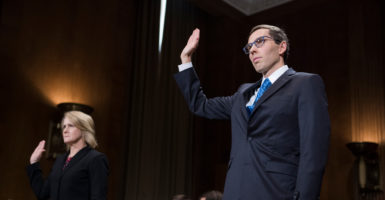The 115th Congress is almost finished, with the Senate expected to adjourn by Dec. 14. What does that mean for the process of filling positions in the judicial and executive branches?
First, here’s how it usually works. The majority and minority typically agree to confirm a group of nominees in the last few days of a Congress. For example, the Senate confirmed 19 judges in the closing days of the 111th Congress under President Barack Obama, 20 judges at the end of the 107th Congress under President George W. Bush, and 28 judges when the 103rd Congress finished under President Bill Clinton.
But it takes two to tango, and Senate Democrats have not cooperated in any element of the confirmation process. In fact, they have set new records and launched new tactics in making the process for approving President Donald Trump’s judicial nominees as slow and laborious as possible.
That said, 32 nominations to life-tenured federal court positions are on the Senate’s executive calendar and ready for confirmation.
Unfortunately, there’s another reason why the usual batch of confirmations may not happen this year. Outgoing Sen. Jeff Flake, R-Ariz., says he will oppose Trump’s nominees in the Judiciary Committee and on the Senate floor until the Senate votes on S.2644, a bill to limit the president’s authority to remove a special counsel. Other senators object to bringing up this legislation because they believe it is unconstitutional.
Since the partisan balance is so narrow, this is a little like the irresistible force meeting the immovable object. This stalemate may just break the tradition of end-of-Congress confirmations.
Senate Rule 31 dictates what happens next. It states that nominations “neither confirmed nor rejected during the session at which they are made” must be re-submitted before the Senate can act on them. In other words, nominations pending when the 115th Congress adjourns will expire and be returned to the president.
This means that, without more confirmations, no less than 67 judicial nominations—the 32 before the full Senate and another 35 in the Judiciary Committee—would be returned to the president.
Presidents usually re-submit virtually all of the nominations the Senate returns to them. By one month into the next Congress, Obama had re-submitted 42 of 43 returned nominations and Bush had re-nominated 29 of 30.
It’s likely that Trump will do the same, sending those nominations back to the Judiciary Committee.
While hearings from the current Congress will not have to be repeated, this just adds more time to a process that has been unnecessarily bogged down already. We are in the longest period of triple-digit judicial vacancies in more than 25 years, and vacancies are actually 13 percent higher than when Trump took office.
There is no legitimate reason that the Senate cannot follow its traditional pattern of confirming a significant number of judicial nominees before adjournment, most of whom are not controversial.
On Day One of the 116th Congress, the enlarged Senate Republican majority should press ahead with firm resolve so that the judiciary can fulfill its constitutional responsibilities.





























